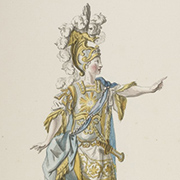The new edition of the opera “Dardanus” by Jean-Philippe Rameau in the version from May 1744 presents the work in the definitive form intended by the composer.
After Hippolyte et Aricie (1733) and Castor et Pollux (1737), Dardanus was Rameau’s third “tragédie lyrique” to be performed in Paris. This work was to have a unique history since it was the first to be presented in two distinctly different versions within the space of just five years. The libretto by Leclerc de La Bruère describes a love story between the young warrior Dardanus who is waging war against Teucer, King of Phrygia, and Teucer’s daughter Iphise. The young woman is promised to another warrior, Anténor, an ally of Teucer, but she succumbs to the forbidden love. After various twists and turns she is united with Dardanus, thanks to the intervention of the goddess Venus who finally breaks Teucer’s intransigence. When Rameau staged Dardanus at the Académie Royale de Musique in Paris in November 1739, he faced much criticism because of the implausibility of the libretto by Leclerc de La Bruère. The opera was consequently a flop, despite all its musical richness.
However, Rameau was not deterred, and in 1744 decided to revive the work. For this, he got rid of the elements of the merveilleux (spectacular and decorative staging effects) in favour of portraying the passions. For the reprise, the prologue and the second act were only lightly revised, whilst the last three acts were completely new. The merveilleux of the fourth act (Dardanus’ sleep and his fight with the monster) was replaced by a splendid scene at the beginning of the act depicting the despairing Dardanus in prison. However, from 15 May 1744 onwards, that is less than three weeks after the new premiere, Rameau revised the major part of the third act, the three last scenes of the fourth, and the divertissement of the fifth act in turn, probably because some parts were overlong. These revisions did not radically affect the essence of the tragedy, but tightened up the dramatic action. The roles of Iphise and Anténor also changed compared with the 1739 version since the Princess now played a more active part: in the fourth act she decides to liberate Dardanus, so that he can escape from Anténor, who plans to murder him. Spurred on by jealousy and rejection, Anténor feels driven to hatch a plan for Dardanus’ disappearance, making him rather less of a hero.
There is therefore not just one version of Dardanus dating from 1744, but two for the last three acts. The new critical edition by Denis Herlin is the first attempt to recreate the version from May 1744. At the same time, the Appendices provide performers with the complete material from the April 1744 version; many parts of this have not been heard since then. When it was revived in 1760 Dardanus became one of Rameau’s most successful operas, remaining in the repertoire until 1771. Although he cut the prologue, Rameau made just minor alterations in the May 1744 version. These few alterations are also contained in the new critical edition.
When Rameau published an edition of Dardanus in April 1744, he had “Nouvelle tragédie” added to the title page; but he did not do the same for other operas revised later. Thus in his eyes, the 1744 version of Dardanus evidently constituted a largely new opera, although the music is identical to the 1739 version in many passages.
Denis Herlin
(from „[t]akte" 1/2020 – translation: Elizabeth Robinson)



